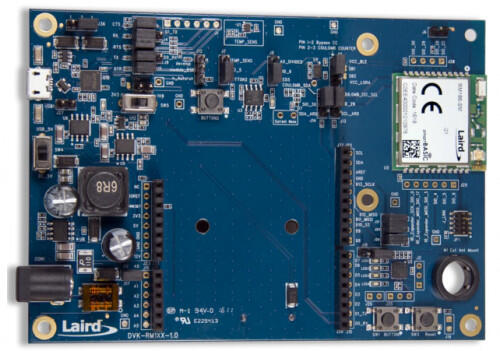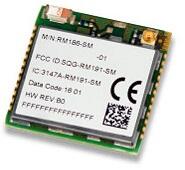Laird Connectivity RM1xx DVK
Overview
Laird Connectivity’s RM1xx is a module which integrates both LoRa and BLE communications, powered by a Nordic Semiconductor nRF51822 ARM Cortex-M0 CPU and on-board Semtech SX1272 LoRa RF chip. This board supports the RM1xx on the RM1xx development board - RM191 for the 915MHz version and RM186 for the 868MHz version.
This development kit has the following features:
ADC
CLOCK
FLASH
GPIO
I2C
NVIC
PWM
RADIO (Bluetooth Low Energy)
RTC
Segger RTT (RTT Console)
SPI
UART
WDT

RM1xx development kit (DVK) (Credit: Laird Connectivity)

RM1xx module (Credit: Laird Connectivity)
More information about the module can be found on the RM1xx homepage [1].
The Nordic Semiconductor Infocenter [2] contains the processor’s information and the datasheet.
Hardware
The RM1xx has two internal oscillators. The frequency of the slow clock is 32.768KHz. The frequency of the main clock is 16MHz.
Supported Features
The rm1xx_dvk board configuration supports the following hardware features:
Interface |
Controller |
Driver/Component |
|---|---|---|
ADC |
on-chip |
adc |
CLOCK |
on-chip |
clock_control |
FLASH |
on-chip |
flash |
GPIO |
on-chip |
gpio |
I2C(M) |
on-chip |
i2c |
NVIC |
on-chip |
arch/arm |
PWM |
on-chip |
pwm |
RTC |
on-chip |
system clock |
RTT |
Segger |
console |
SPI(M/S) |
on-chip |
spi |
SPU |
on-chip |
system protection |
UART |
on-chip |
serial |
WDT |
on-chip |
watchdog |
Other hardware features have not been enabled yet for this board. See Nordic Semiconductor Infocenter [2] for a complete list of hardware features.
Connections and IOs
The development board features a Microchip MCP23S08 SPI port expander - note that this is not currently supported in Zephyr.
Refer to the Microchip MCP23S08 datasheet [5] for further details.
Internal Memory
EEPROM Memory
A 512KB (4Mb) Adesto AT25DF041B EEPROM is available via SPI for storage of infrequently updated data and small datasets and can be used with the spi-nor driver. Note that the EEPROM shares the same SPI bus as the SX1272 LoRa transceiver so priority access should be given to the LoRa radio.
Refer to the Adesto AT25DF041B datasheet [3] for further details.
LoRa
A Semtech SX1272 transceiver chip is present in the module which can be used in 915MHz LoRa frequency ranges if using an RM191 module or 868MHz LoRa frequency ranges if uses an RM186 module
Refer to the Semtech SX1272 datasheet [4] for further details.
Programming and Debugging
Flashing
Follow the instructions in the Nordic nRF5x Segger J-Link page to install and configure all the necessary software. Further information can be found in Flashing. Then build and flash applications as usual (see Building an Application and Run an Application for more details).
Here is an example for the Hello World application.
First, run your favorite terminal program to listen for output.
$ minicom -D <tty_device> -b 115200
Replace <tty_device> with the port where the board nRF51 DK
can be found. For example, under Linux, /dev/ttyACM0.
Then build and flash the application in the usual way.
# From the root of the zephyr repository
west build -b rm1xx_dvk samples/hello_world
west flash
Debugging
Refer to the Nordic nRF5x Segger J-Link page to learn about debugging boards with a Segger IC.
